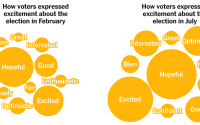Many Ohio Voters Thought Referendum’s Backers Were Not Being Honest
A little after 2 p.m. on Tuesday, David Chrzanowski, 31, walked into Knox Presbyterian Church in Cincinnati, pushing his baby daughter in a stroller. He was there to vote on Issue 1, a measure meant to raise the vote threshold needed to approve a state constitutional amendment from a simple majority, as most states require, to 60 percent.
It was a change that Mr. Chrzanowski, an engineer who described his politics as center right, might have been open to considering, he said — if that were what it was really about.
“Everyone kind of knows,” said Mr. Chrzanowski, who, along with 57 percent of Ohio voters on Tuesday, cast his ballot against Issue 1. “It seems underhanded. It doesn’t seem like the way we should conduct our politics.”
For months, it had been apparent that Issue 1, advertised as a measure to safeguard the State Constitution from wealthy out-of-state interests, was primarily about blocking an abortion-rights amendment that will be on the November ballot. Supporters of the measure hardly kept this a secret, and campaign donors lined up accordingly: Much of the money in support came from Susan B. Anthony Pro-Life America, a Washington-based anti-abortion advocacy group.
“It’s a little bit of a magical trick,” said Rebecca Ferris, 74, a registered Republican who voted against Issue 1. “The people who engineered it have covered it so that you don’t really see the cards that are there.”
For many Ohioans, this barely concealed political strategizing is what clinched their decision to come out and vote against the measure — and come out they did, in a turnout that nearly doubled that of last year’s primary election for Congress and the governor’s office.
It is likely that most of the votes against the referendum reflected the views of people who saw Issue 1 as a threat to abortion rights. The final tally lined up neatly with polling about the abortion-rights amendment. This brought people out to vote even in Republican strongholds like Warren County in the Cincinnati suburbs.
“I’m 89 years old, and I’m fed up with old men telling women how to take care of their reproduction and their sex lives,” said Thomas McAninch, who cast his vote in the Mason Municipal Center. “If men was having babies, there wouldn’t be none of this nonsense.”
Still, more than three dozen interviews with voters on Monday and Tuesday revealed a sizable segment of the electorate, and possibly a decisive one, that was offended by the whole effort. People grumbled that the campaign for Issue 1 was “disingenuous,” a “game,” or a “sneaky tactic,” and that its backers were trying to “pull a fast one.” This sentiment was bipartisan, perhaps explaining why the outcome on Tuesday was close in counties that former President Donald J. Trump won by 20 points or more.
Several voters interviewed pointed out that only nine months earlier, Republican lawmakers had outlawed virtually all August elections, arguing that they were too expensive and that too few voters turned out for them. They then reversed course when it became clear that the abortion-rights amendment was on its way to the ballot.
“People here can see through all that,” said George Graham, 59, a minister in the Cleveland suburb of Lakewood.
Some of Issue 1’s supporters did emphasize the principles of protecting the constitution from wealthy interests or passing political whims, or safeguarding the state against “mob rule,” as Andrew Hood, 34, said on his way out of the municipal center in Mason.
But others forthrightly acknowledged that “abortion is key,” as Virginia Cox, 82, said on her way to vote in Clermont County.
And some of those who spoke of shielding the Constitution were blunt about what they saw as threats. “The liberals,” said one voter in the Cleveland suburb of Strongsville. “It is just a party thing,” said another.
As reliably Republican as Ohio has come to be, it might have seemed that party loyalty would have been enough for Issue 1 to prevail. The state voted for Mr. Trump by an eight-point margin in 2020, and with the exception of Sherrod Brown, the U.S. senator, all officials elected statewide are Republicans, most of whom won handily last fall.
Still, Ohio as a whole is not as far to the right as one might infer from the lopsided Republican margins in its Legislature, a function of gerrymandering and the uneven rural-urban distribution of partisanship. Some polling has found that when it comes to specific policies — on matters like abortion and gun regulations — Ohio voters may not be as conservative as many of the politicians they vote for.
“There’s a big gap between where people are on issues and where people are on identifying with candidates,” said Thomas Sutton, the director of Baldwin Wallace University’s Community Research Institute, which conducted a statewide poll on the issues last fall.
In focus groups he recently conducted in some of the most solidly Republican areas of the state, Professor Sutton found that party loyalty did not cancel out a distaste for Issue 1 and the possibility it could undermine the popular will.
“People were concerned on a couple of different levels,” he said. “No. 1 was: You are diminishing my ability to vote on these constitutional issues. No. 2 was the way in which this was all done.”
Many voters said that, beyond abortion, they were simply not comfortable with making it harder to change the Constitution.
“Is the abortion issue important? Yes, but it’s more than that for me,” said Darla Carlson, a retired schoolteacher who was casting her vote in Shaker Heights. “We are stopping this before it gets any further.”
Michael Wines contributed reporting.


